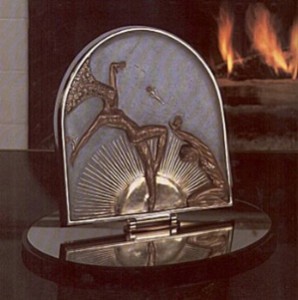If you are new to fine art collecting, you may have asked yourself “What is the difference between Art Deco and Art Nouveau?” If you have ever asked yourself this, you are not alone. Many people mistake one for the other. To make sure you know the crucial differences between the two similar styles, Barnett Fine Art has composed a guide to the signifying qualities of both Art Deco and Art Nouveau.
The Similarities of Art Deco and Art Nouveau
Both Art Deco and Art Nouveau share more similarities than just having “art” in the name. This is why they are often confused for one another. Both art movements were reactions to major world events. Art Nouveau was a result of the Industrial Revolution, while Art Deco was a result of WWI. These reactionary, modernist art movements also tend to look similar. And easy way to separate the two is to associate decorative, flowery designs with Art Nouveau and sleek, machinistic designs with Art Deco.
The Features of Art Nouveau
Art Nouveau, meaning “New Art” in French, was a predominant art style from around 1880 until WWI. A new industrial aesthetic emerged in Europe, and American artists embraced this aesthetic wholeheartedly, creating paintings, buildings, jewelry, and other works of art in the unique style. This style featured naturalistic elements in a stylized form. Insects, weeds, and even fairies were all elements that were commonly found in Art Nouveau. Curved lines are a defining feature of Art Nouveau, as artists tried to capture shapes found in nature and combine them with arcs, parabolas, and other circular architectural forms. Alphonse Mucha, Henri de Toulouse-Lautrec, and Gustav Klimt are all Art Nouveau artists.
The Features of Art Deco
Art Deco emerged after WWI during the Jazz Age of the 1920s. Art Deco played into the opulent and extravagant styles that became popular after the war. Art Deco also utilizes curves and natural elements, but sharp, jagged edges and bold designs like sunbursts and zig zags were more common. Any natural elements used in Art Deco tended to be graphic or textural, like zebra skin or jagged fern leaves. Art Deco relied heavily on chrome, stainless steel, and inlaid wood as artistic mediums. Architecture, furniture, and even cars were affected by the Art Deco movement. Frank Lloyd Wright, Tamara de Lempicka, and Erté are all Art Deco artists.
Keep up with our blog for the latest art news.
Questions? Call Patty Barnett at 504.524.2922
Like us on Facebook and follow us on Twitter and share with your friends.
Tags: Art Deco, art history, Art Nouveau, Erte







